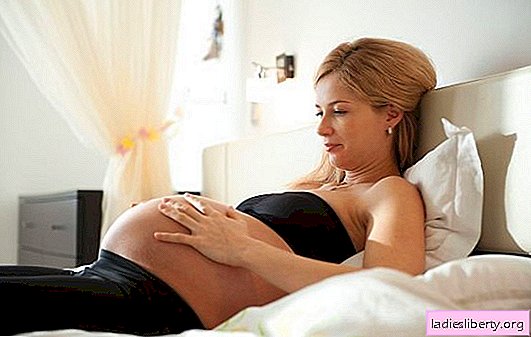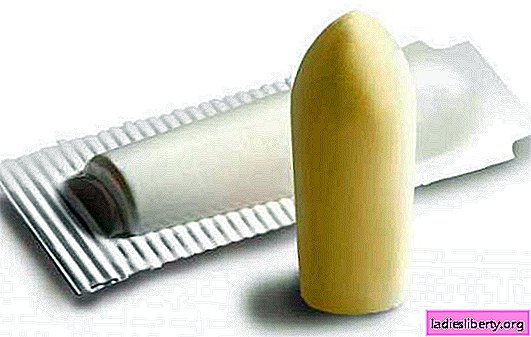
In many women, pregnancy is accompanied not only by positive emotions, but also by periodically arising pains of various locations and intensities.
Units of future mothers were lucky for nine months not to experience any unnatural sensations.
In most cases, with minor and short-term pain, doctors reassure pregnant women, explaining what is happening with a natural physiological rearrangement of the body.
But some situations require closer examination and timely treatment.
So, in case of severe pains of the pubic bone during pregnancy, there is a real threat to the health of the mother and her ability to give birth on her own.
Physiological causes of pubic bone pain during pregnancy
The pelvic bones, which include the pubic bone, perceive the greatest load upon bearing the child. In addition, if they remained in their natural state, they would not allow the woman to resolve her burden on her own. The articulated joints in this area are practically motionless, which allows you to reliably hold the internal organs of the peritoneum.
Only during pregnancy, passing the middle of the term, the hormone relaxin begins to be actively produced, which significantly changes the structure of bones, as well as ligaments and tendons. Under its influence, the birth canal is gradually preparing, which ensures that the child passes through them without hindrance. Ligaments have elasticity, allowing the bones to disperse, which have become more loose. The pubic bone, consisting of paired pubic bones, is also subject to change. Therefore, the occurrence of minor pains of the pubic bone during pregnancy in the later stages should not cause anxiety, as it is explained by physiological changes:
• increased mechanical stress on the pelvic bones;
• relaxation of ligaments, as well as cartilage compounds under the influence of hormones;
• violation of a woman’s posture in late pregnancy.
Pathological pains of the pubic bone during pregnancy
In addition to natural processes, pubic bone pain during pregnancy can signal pathology. In the body of a woman, old diseases can appear that become aggravated during pregnancy or there may be specific problems associated with pregnancy.
Symphysiopathy
A significant discrepancy in the pubic joint causes unbearable pain in women, which intensifies during walking, turning in bed, when trying to spread or raise legs, while climbing the flight of stairs.
The reasons for this phenomenon have not been thoroughly clarified by doctors, but situations in the form of:
• a large amount of amniotic fluid;
• rather large fruit;
• excess hormone relaxin;
• a woman's predisposition to joint diseases;
• deficiency of vitamin D, affecting the absorption of calcium;
• imbalance of trace elements magnesium, calcium and phosphorus.
Localization of pain is observed in the area of the pubic joint, but can spread to the lower abdomen, in the groin and perineum. Unpleasant sensations also occur in the thigh, leg and lower back. Pain provokes:
• duck gait;
• inability to raise a straight leg from a prone position;
• the impossibility of taking the legs to the side and standing on one leg.
Pathology in no way affects the course of pregnancy and the condition of the fetus, but is a threat to the mother. In this situation, there is a predisposition to a complete rupture of the pubic joint, which deprives a woman of the ability to move independently. In most cases, when diagnosing symphysiopathy and fixing bone discrepancy of more than 10 mm, self-delivery is prohibited, and a cesarean section is required.
Musculoskeletal pathology
1. Osteitis of the pubic bones is manifested by painful inflammation of all tissues in the area of the pubic joint. It can be triggered by both pregnancy and previous urogenital interventions, injuries, as well as spondylitis.
2. Osteomyelitis of the pubic joints is an infectious pathology that is quite rare and is associated with complications of surgical interventions performed two weeks to three months before the exacerbation.
3. Osteomalacia caused by pregnancy is associated with a significant lack of vitamin D. In addition to soreness of the pubic bone, pain in the spine, ribs and sternum is noted.
Other pathologies that cause pubic pain during pregnancy
1. With short-term osteoporosis during pregnancy, the hip and other joints may be affected. In this case, pain is observed in the thighs from the groin with redistribution to the knee and pubic bone.
2. An increase in lumbar lordosis associated with pregnancy causes severe pain not only in the lower back, but also in the buttocks, legs and pubic region. With approaching and during childbirth, such pain intensifies, but after delivery completely disappears.
3. In case of urinary tract infections, pain can be observed behind the pubic bone, which is often confused during diagnosis with pathologies of the pubic joint. Unlike symphysitis, motor abilities and gait are not disturbed, there is no pain over the pubis during palpation.
Diagnosis of pubic bone pain during pregnancy
Regardless of the intensity of pain in the pubic area during pregnancy, you should inform your gynecologist about the change in condition. Only a qualified inspection will reveal the severity of the changes. The physician will determine the feasibility of a further examination, which may include if there is a suspicion of symphysitis:
• examination by a physiotherapist to confirm the symptom of Trendelenburg, during which there is a lowering of the buttocks while standing on one leg and pain during palpation of the pubic bones;
• examination to identify the Patrick-Faber symptom, which is manifested by pain in the area of the sacroiliac joints during simultaneous fixation of the iliac bones by the doctor and the patient bending the legs in the thigh with the foot positioning to the opposite knee.
• X-ray photographs of the pelvis, on which the discrepancy of the pubic bones is recorded, as well as their displacement in the pictures taken while the patient is standing on one leg (X-ray examination during pregnancy is used in extreme cases).
For the diagnosis of other pathologies, in addition to examinations by palpation and x-rays, apply specific examination methodswhich may consist of:
• from blood and urine cultures to detect infections;
• from ultrasound examinations;
• urine analysis using indicator strips;
• blood tests, other materials for the detection of trace elements.
Treatment of pubic bone pain during pregnancy
If no pathologies and pains of the pubic bone during pregnancy are detected due to natural processes, special treatment is not required.
If infectious processes are detected, therapy with antibiotics safe during pregnancy is required.
Deviations caused by an imbalance of trace elements and vitamin are easily corrected by diet or intake of vitamin complexes designed for pregnant women.
Excessive discrepancy of the pubic bones during pregnancy is not treated. Therapy is aimed at preventing further progress of the pathology and improving the condition of the pregnant woman.
For this Doctors recommend:
• in case of severe pain, take approved pain medication such as No-shpa or use Menovazin solution to rub the painful area;
• if there is inflammation in the pubic bone, use ointments in the form of Betalgon gel or Chondroxide;
• limit motor activity, if possible, to exclude movement on stairs;
• try to sit less, and in a standing position be no more than half an hour, distributing the weight on both legs;
• reduce the load on the joints and spine, using a special roller under the legs for night rest;
• apply special orthopedic bandages;
• when lifting from the bed, redistribute the load on the upper body;
• apply special exercises of medical gymnastics to relieve tension.
If no improvement is observed, the woman may be offered treatment in a hospital. The feasibility of having a cesarean section with symphysitis is decided after 30-32 weeks, based on the degree of discrepancy between the bones, the size of the fetus, and the condition of the other pelvic bones of the pregnant woman.
Prevention of pubic bone pain during pregnancy
To prevent complications in the form of a divergence of the pubic joint, it is necessary from the beginning of pregnancy:
1. Pay enough attention to physical healing exercises that can significantly strengthen and elasticize joints and ligaments.
2. Provide a balanced diet, including products containing essential micronutrients and vitamin.
3. Take additional vitamin complexes at doctor's recommendation.
4. Avoid excessive loads on the joints and be able to properly distribute them.
5. Follow the rest recommended by the physician.
6. With a rapidly expanding abdomen, use a bandage to support it in order to prevent excess pressure on the pubic bones.
Not a few pregnant women experience pubic bone pain. And only some are diagnosed with serious pathologies.
However, it should be remembered that such deviations, in addition to those caused by infectious factors, do not threaten the baby, and the correct diagnosis made in time will help get rid of strong pain.











